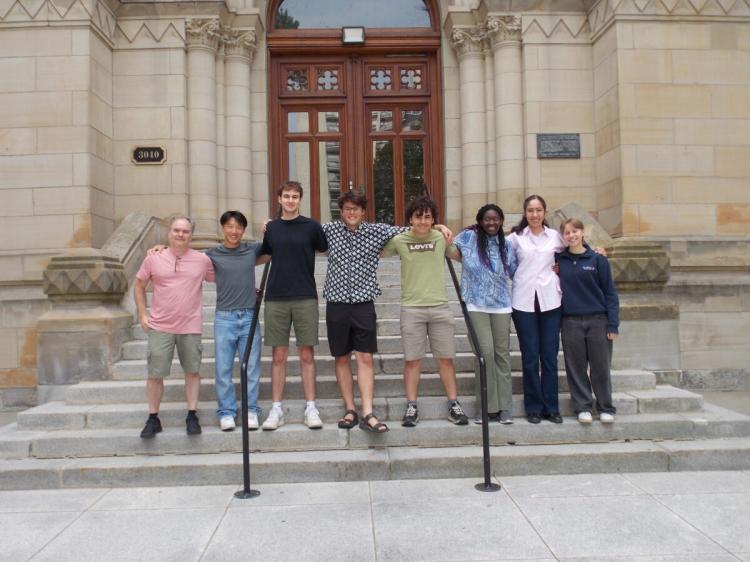
Nine Dawson College students are heading to Hamburg this September after winning a major international science competition. The "Dawson Technicolor" team will spend two weeks at DESY, Germany's renowned particle physics laboratory, to test their own detector using a particle accelerator.
The student-initiated project began nearly a year ago in the context of the Dawson High Energy Physics group, accompanied by Physics faculty members Manuel Toharia and Joel Trudeau. With funding from the Dawson Foundation, the team designed and built a muon detector called The Scintillating Chamber during the winter 2025 semester. Teacher Manuel believes this prototype was key to the team's winning proposal in CERN's prestigious Beamline for Schools (BL4S) competition.
Out of 508 participating schools worldwide, the largest number in the competition's history, Dawson was among just five winning teams. They are the first group from Quebec and only the second from Canada to achieve this distinction since the program began in 2014.
"It is absolutely amazing that a group of CEGEP students can submit their experiment ideas and that scientists at some of the largest scientific institutions in the world will take them seriously and help them pursue their ideas," said team member Leandro Perez Moran, who is 17 and in Enriched Pure and Applied Science. "We are living proof that you don't need a degree to consider yourself a scientist, the only requirements are curiosity and the will to persevere through the problems you will surely meet."
"They are doing PhD-level work," Manuel said, noting that most of the students are only starting their second year at Dawson but are already working well beyond the scope of typical CEGEP or even undergraduate science studies.
The students invested months of effort in designing, building, coding and coordinating. "Our project requires cooperation from every person in our group," they explained. "Since the tasks are shared, the hardware and the software must be in tune with each other. Everyone has responsibilities to fulfill to make sure everything goes smoothly once all the various parts are put together."
Accessibility is an important goal for the team. "Traditional detectors are impractical to build and dangerous to operate," said team leader Tian Yi (Alex) Xia, who is 18 and in Enriched Pure and Applied Science. "The Scintillating Chamber was designed to address these issues by using safer standard parts and providing open-source documentation online."
Their work also drew attention and support from well beyond Dawson. "I've been amazed by the amount of support our team has received not just from Dawson staff, but also from universities and the private sector," said co-team leader Aljoscha Ziegler, who is 18 and in the Enriched Pure and Applied Science program. "Having been taken seriously by professionals in the field of particle physics is very rewarding and a nice validation of the efforts our team has been making."
Teammate Danah Dézémé, who is 18 and in Pure and Applied Science, added: "With the right funding and support, any research project can come to life and enrich the scientific community. I've also come to realize the importance of patience and perseverance in science because things will go wrong, and we have to keep pushing through in order to learn from our attempts and ultimately succeed."
At DESY, the team's detector will be exposed to a controlled particle beam for testing and calibration. Their scientific question: whether ideas from computer science can inspire new designs in particle physics. As they explained, "the arrangement of the rods is inspired by binary encoding, a method commonly used by computer scientists."
From September 10-25, the students will set up the detector, conduct experiments, collect data, and troubleshoot alongside professional researchers. They hope to learn "how (the DESY scientists) design their experiments, how they ensure no sources of error are included in experiments and what anomalies the DESY scientists are studying."
Team leader Alex Xia credited the Dawson Foundation for making the project possible: "The Student Academic Growth and Enrichment Fund was key to procuring all of our parts; this project would have been impossible without their pledge, and confidence in our vision. I thank them again, on behalf of the whole team, for believing in us."
The team plans to continue working on the project when they return from Germany: "We hope to continue refining our detector and find different applications for it. One avenue we're hoping to follow is using our detector for tomography, which is the process of measuring muon flux through a volume to come up with its image and size. We're hoping to use this method to measure ice thickness, which could then be used in spatial exploration."
The Dawson Technicolor team includes David Birnbaum, Tykhon Byshkin, Matvey Chirchikov, Danah Dézémé, Arij Mohamedi, Leandro Perez Moran, Evan Parasol, Ari Polterovich, Milo Belarbi-Tabourier, Tian Yi (Alex) Xia, Chun On (Andy) Yu, and Aljoscha Ziegler.













